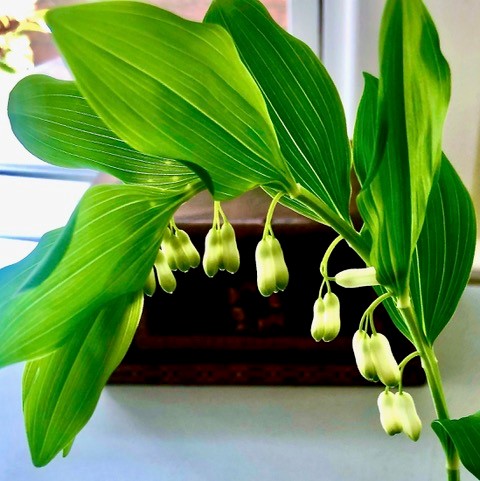April 3rd, 2024Glen, about the house …

Hi Glen,
I wonder if you could identify the plant in the photograph for me? I was told it was probably a Solomon’s Seal. I think it might be but it looks a little different to others I’ve seen. This one was flourishing in a large pot on a shaded porch.
Thanks, an avid reader, Sheryl.
Hi Sheryl, it certainly is one of the many forms of polygonatum or Solomon’s Seal. This one appears to be polygonatum odoratum or angular Solomon’s Seal.
Polygonatum, also known as King Solomon’s Seal, is a genus of flowering plants placed in the asparagaceae subfamily. It was originally classified in the lily family, liliaceae.
Solomon’s Seal is a genus of elegant perennial plants native to woodland areas of several continents including North America, a genus distributed throughout the temperate Northern Hemisphere. Most of the approximately 63 species occur in Asia with 20 or so belonging to China.
Unfortunately, although a distant relative of our flavoursome asparagus, this bunch are certainly not safe for the table but very desirable for your garden.
The small, tubular flowers which can come in white, green or pink are charming. But it’s the slender arching stems and long, lance-shaped leaves that make Solomon’s Seal such a favourite in shady settings. Small blackish berries remain after the flowers fade, to be enjoyed by birds.
Once established, Solomon’s Seal slowly spreads and creates a blanket of foliage that turns a golden yellow in autumn.
Most of Solomon’s Seal varieties will grow from 30-60cm in height and rapidly spread in breadth. If planted at 60cm to 1-metre apart in beds you will soon have a beautiful carpet of colourful foliage and, in time, flowers.
Next autumn you will be able to divide the plants and take the new little plantlets from around their bases to replant in the gaps or other beds.
Dividing and tidying up your perennials
Between now and late April you can increase your stock of perennial plants by division. Clumps of aster, erigeron, penstemon, scabious, campanula, shasta daisies and similar plants can be lifted and split apart by the two-fork method using a pair of garden forks, or spades if necessary, to lever the clump apart.
The sturdiest younger portions can be replanted in good soil to which a fairly liberal dressing of blood and bone or similar fertiliser has been added.
One or two of the more popular perennial plants are best left until early spring. These include cannas and those that normally die back to a dormant crown during the winter months.
In spring, at the first sign of new growth, the plants can be lifted and divided without damage. At that time of year the warming soil will encourage rapid root growth.
As for the other perennials it is usual to cut them back and remove the dead leaves as soon as they have finished flowering. Not only does it make for a cleaner looking garden it also reduces the number of hiding places for slugs, snails and other leaf eating pests.
Obviously, in areas of severe frosts, these should be left until warmer weather. Many plants will begin to make new shoots when there are a few days of mild weather in late winter and a subsequent hard frost can damage that young growth.
If the old leaves and dry growth are left on, they protect these shoots and are just as well removed after frosts have finished and the new growths are well established.
Got a gardening query? Email glenzgarden@gmail.com










